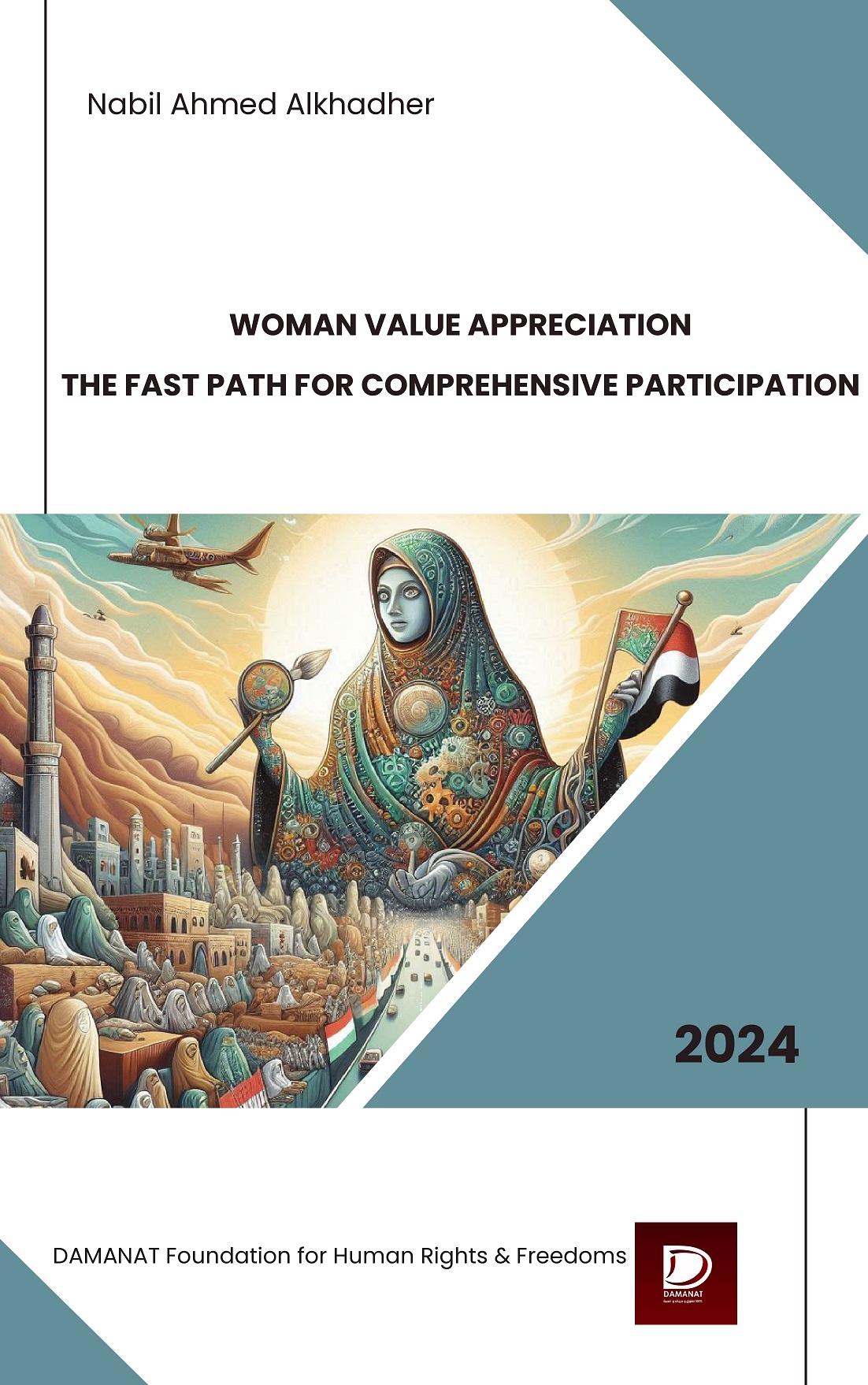Mon,Dec 15 ,2025

Support Women's Parliamentary Participation through Information Technology
2025-04-23
The importance of the Internet grows on a daily basis, and rapidly interferes with our public and private lives; e-mail services offers a faster communication, websites that introduce governments, institutions, and individuals to readers and interested people, blogs that have become more functionally similar to newspapers, introducing a poet, author, artist, journalist, and activist to audience easily and for free, social networks, that have begun to gain a great value in each person's life, linking him with the world, besides numerous audiovisual technologies that grant each person the opportunity of becoming an owner of a famous channel, an influential radio station, or an important electronic newspaper.
Unfortunately, this technology, with all privileges, is still characterized by muscular domination "mostly-used by males", while women are taking their first steps. This raises the question; is there any possibility to increase the presence of women on The Internet, and perhaps, dedicate it to serve their main issues, such as violence against women, participation in public and political life, and women issues advocacy in fields of education, health, media and other relevant issues.
Women's political participation was limited throughout the previous elections, whether in candidacy or election. Perhaps, due to the fact that the parties did not nominate many women in the electoral districts, or because the parties were convinced that female candidates did not win against their competitors for reasons related to the nature of Yemeni society and its view of women.
Undoubtedly, one of the key reasons is the weakness of electoral campaigns carried out by women, compared to men in the same society. The following pages do not shed the light on mistakes, defects, or shortcomings in electoral campaigns of women on the ground; however, they provide some tools and techniques that women can take advantage of in the digital environment, along with electoral campaigns carried out in the street. It focuses on women who wish to participate in politics and parliament, considering the usage of these new technologies in media work to reach the targeted audience through online information, and to launch their electoral campaigns, using digital tools; therefore, they have an intention to further their information about
The Internet and usage of digital tools to reach voters. These paperwork presents some experiments, tools and success stories of other countries in this field.
Despite the fact that the Internet is a technology expected, at the beginning, to influence its environment only, by hands of sole specialists, it has gone viral among a larger category by time, effecting personal lives and social progress, in general.
This category involves both genders, not only males. This tremendous technology is characterized by neutrality and gender-blindness. Therefore, women have the right to access the Internet, as men have, for the purpose of communication, work and activities. Compared to men, women have faced challenges to use the Internet for reasons that are beyond the neutral nature of such equality-based technology.
It has been falling under muscular domination, under which several opportunities and resources furtherly fall, on the ground. Even in the developed countries, women have not had the full opportunity to Internet access and enjoyed the maximum advantage, as men. Therefore, The Internet must furtherly-characterized by democracy and equalization of females' access, such as males.
This paperwork aims at addressing several questions, as follows:
- What is Internet technology? What are the strengths of this technology in terms of social and political change, in particular?
- What is the status of the Internet in Yemen in terms of freedom, infrastructure and usage by users in general, and women in particular?
- Who benefits more from the Internet at the present time?
- Who benefits from the Internet the most at the moment?
- What are the challenges that limit women's access to the Internet in Yemen?
- Have you used the Internet, so far, in topics on serving societal and feminist issues, or is it still a technology for the educated and specialized elite?
- Who are the stakeholders in women's access to the Internet and what are their assumed roles?
- What are the tools available on the Internet that women can use to support their public issues, and in particular, the participation of Yemeni women in parliament?
Is there an action plan to support women's participation in parliament through information technology?
Participation of women in Parliament means a change in public policies that serve millions of women in Yemen. As a result, supporting their occupation of this position is a top priority. In light of the developing political process in Yemen, this paperwork aims at providing women with some tools and strategies that ensure their reach to voters, through the digital environment, along with the tangible environment in the Yemeni street.
Women & Digital Environment in Yemen
What is Internet technology? What are strengths of this technology in terms of social and political change, in particular?
The Internet has been used in many aspects of development in the political, social, health, educational and almost all variations in life, and has changed several ways of interaction among people, especially in social networks. Such networks tip the balance of digital social communication and digital relations over tangible social interactions.
At the healthcare level, several websites, blogs, and accounts have been established to provide awareness of health issues, such as HIV/AIDS, cancer, up-to contagious or seasonal diseases.
This awareness includes some female health issues, such as reproductive health, sexual health, and gynecological diseases, such as breast cancer.
At the educational level, several websites have been launched to provide e-learning and self-learning, online application to scholarships, open learning, distance learning among other digital learning types.
At the social level, the Internet has contributed to strengthening networking among users, especially for demonstrations and meetings to advocate fundamental social issues.
At the political level, the Internet's importance grows along with establishing blogs, in the current time, and the so-called governmental blogging, through which decision-makers can be accessible online via their blogs that promote their policies and their development plans in their local society. Decision-makers can be informed via their blogs about citizens' comments on their plans and strategies, besides several advocacy and lobbying complaints for political issues, at both global and Arab levels. Regarding women in Yemen, the Internet has contributed to promote social and political issues of women.
At the social level, campaigns to combat violence against women and early marriage have been launched. At the political level, it is too early to invest in the Internet, because such technology is novel, and activists, including women, have not known yet, the importance of investing in the Internet in their favor. As a result, this paper aims at bridging some gaps.
What are the challenges that limit women's access to The Internet in Yemen?
It is easily possible, with the naked eye and without the need for statistics, to know that women are a minority in using the Internet and have advantages of the vital digital environment in education, health and key women's issues in Yemen. Such restrictions are not a result of women's inaccessibility to Internet clubs and computers that spread all over the main cities, but for being a men-only, and a very small number of women can take such advantage.
Several challenges face women, but not men, who wish to participate in politics within societies that use to put obstacles in front of women, while supporting men to reach decision-making positions. This paperwork, entitled “Support Women’s Parliamentary Participation Through Information Technology”, reveals that women combat a much greater number of challenges than men, including:
Infrastructure of Internet
The Internet in Yemen is considered the poorest in the Arab and the entire world. The service is not available to all beneficiaries at the level of penetration, and is considered the slowest. In some war-torn countries, such as Somalia, Internet speed is considered faster than Yemen, in which some major cities (Sana’a, Aden, Al-Hodeidah, and Taiz) enjoy a good quality of service, compared to other governorates (Al-Mahweet, Sa’ada, Dhamar, and other cities) and is even worst in the rural areas, which lack to access to The Internet. Perhaps, society has made it even more difficult by establishing tiny scattered villages.
Statistics reveal that residential complexes may contain 100,000 residential groups; however, Yemen is one of rarest countries to establish a village of 4 – 10 houses. As a result, the government faces challenges to provide such micro residential groups with electricity, water and the Internet services, especially that most residential groups are randomly-scattered on the top of mountains or desert outskirts, which makes them undetectable and highly-expensive to be covered.
Noteworthy, the intensive usage of cellphones increases the accessibility to Internet; however, high cost for Internet service set by mobile companies in Yemen forms another challenge, besides the scattered populated areas that made it arduous to provide their residents with education, which is a priority to use the Internet, cellphone and technology.
Gender-Based Distinction in Internet Usage
The Internet service in Yemen is still novel. Furthermore, a large population in Yemen has not been acquainted with the importance of such service at the public and private levels. The majority of The Internet users are the youth, especially the educated segment and those who live in the main cities, such as Sana'a, Al-Hodaida, Aden and Taiz. Regarding women, it is even worse in terms of access to Internet service, because female education has reached its lowest rates, which hinders them from using the Internet and technology appropriately in their public life.
Therefore, women' usage of the Internet to consolidate their parliamentary participation is extremely difficult, and is considered a high expectation and an ambition, in the current time. Supporting women to achieve such a target is a figment of imagination, even for the educated women and those who wish / are capable of enjoying services of the digital environment.
This category of women finds it difficult to enter Internet cafés due to pornography websites that are frequently-visited by men in Yemen, which contributed to label Internet cafés "prohibited" by audiences, just like cinemas that had been closed in the end. Such a reason, despite knowledge, hinders a great number of girls from entering Internet cafes and benefit from it.
In Yemen, the rate of women who enter Internet cafes is poor compared to men who can, anytime, take advantage of the digital environment - of growing importance – despite their dire need. Regarding supporting women's parliamentary participation through information technology, it could be stated that providing them with such accessibility requires active women in dedicating digital tools in promotion and awareness of importance of such matters.
Unfortunately, women must wait for a long time to develop the Internet infrastructure, and enjoy parliamentary participation and pave the path for other women to fill decision-making positions.
Gap in Resources & Strength
This gap is historical and ancient. Men dominate resources in communities in the entire world. Business women and female employees have rarely been on the top of the job hierarchy. This muscular superiority is not different in the status of men and women of medium or limited income. In all social classifications, the muscular domination on resources and power is a character of communal life.
Women's inaccessibility to resources and power renders them incapable of continuing education or have access to Internet, in light of the right to decision-taking by males in family matters, which usually include refusal to women's access to Internet for moral consideration to pornography and cyber harassment via social media, which this paperwork sheds the light on for being one of the major challenges that faces women's access to Internet in Yemen.
Social Challenges
Rates of women's access to the Internet has been decreasing due to social challenges in the Yemeni community, characterized by preservation and traditionality. It tends to protect women from bad social practices; outdoor harassments as a main justification to men's refusal to very basic rights of women, including right to education, work and Internet accessibility. This refusal emerges from deeply-rooted social challenges; illiteracy and inability to handle the new digital world by men themselves, not to mention women.
Cultural Challenges
The first cultural challenge to access to Internet is language, since the key medium of the Internet is English, hindering Internet usage by Yemeni men and women.
The second challenge is technological awareness. The majority of men and women lack knowledge on computers and sophisticated devices - tools to use the Internet – minimizing their benefit from The Internet. Perhaps by time and amid a futuristic social and technological development, such knowledge and beneficiaries of both genders may get wider.
The third challenge is the Internet content; pornography of rapid and cheap access. The community labeled the Internet a stain due to pornography accessibility, and hindering the women' entering to Internet cafes, except in rare cases.
In general, women's access to the Internet in Yemen is still under level for several reasons, including poor infrastructure of Internet in all of the Yemeni cities, save main cities, scarcity of Internet service in villages and rural areas due to the scattered residential complexes, inability to own devices that support Internet accessibility because of the gap in resources and power between men and women, labeling the Internet by the majority of Yemenis as a medium to spread pornography and harassment, and high rates of illiteracy among women in Yemen, compared to most countries of the world.
Women's Internet Access Stakeholders
Global feminism has faced several challenges, some of which are existing in Yemen. The global feminist experiment is strongly-displayed in demonstrations, and relevant national and local events.
The possibility of development in women rights major, and women engagement in political, social, educational and other aspects of life has a place in global communities.
In Yemen, women who consider parliamentary participation must motivate women in local communities to contribute to such consideration. It is widely-known that one of the challenges against women is masculine domination on women's votes, especially in slums and rural areas characterized by higher rates of women's illiteracy, gender-based violence and affiliation to the process of muscular decision-making.
Women of political development sentiment must pay multiple efforts on other women, who form a majority in the local community to bite the electoral scale. Regarding women parliamentary participation through information technology, women activists must post via digital platforms and target other women with Internet access, who interact with their posts to support their penetration to Parliament.
Government
The government must support women's penetration to Parliament to confirm a goodwill of democracy and intention to women's engagement in political, social and economic decision-making process, which is a key indicator to development, freedom, and human rights respect.
The governmental consideration of engagement of a contrary voice that represents women's perspective on development issues is fundamental, since such perspective significantly contributes to the development progress.
Thirdly, supporting women's accessibility to the Internet will elevate the economical level of the country by activating the sleeping female force – the other half of the community – in the environment of the Internet, as a consumer of services provided by state and private sectors. Beyond pragmatic and economical views, the state has an obligation to bridge the digital gap between men and women, and motivate women to shed the light on their issues in digital platforms in order to benefit from the Internet in favor of themselves and their issues, including sharing the topic of this paperwork.
Women's accessibility to decision-making positions ensures the provision of rapid solutions to most female issues, which have a great concern by the government, including complicated issues (reproductive healthcare, gender equality, women rights promotion, and in particular, the rights concluded in Convention on the Elimination of All Forms of Discrimination Against Women, human – including women- rights conventions, Universal Declaration of Human Rights and international rights conventions and International human rights covenants and conventions.
Private Sector
A consideration to the pragmatic aspect is a must, since the activation of the half of the Yemeni community in the digital environment multiplies private sector profits, as a result of service users' expansion. As a result, the private sector and communication chains, in particular, must consider women's accessibility to the Internet a priority to enhance rates of users and consumers.
The private sector is eligible to support civil community activities to train women in using the digital environment, and furthermore, support establishing women clubs to provide women with safe access. As well, the private sector must intensify communication coverage to reach Yemeni rural and isolated areas and provide smooth Internet access anywhere in Yemen. In addition, the private sector must study and innovate solutions that provide accessibility and mitigate challenges against men and women' accessibility.
International Non-Governmental Organizations (INGOs)
International Non-governmental Organizations show a great interest in to women, defend their various rights, build their capabilities to be strong participants in development, and support GBV projects, and comply with human rights international conventions, such as Convention to the Elimination of All Forms of Discrimination Against Women (CEDAW) Operating women-supporting INGOs in Yemen are eligible to build women's capability to handle digital technology and use relevant tools to shed the light on their issues.
INGOs are characterized by large deployment and variation of interventions and targeted beneficial segments by projects and activities.
An acceptable number of INGOs and UN agencies focus on women, as a vital segment of any community.
Some of them operate in IT development, Communications, and the Internet fields, creating an an opportunity to materialize the topic of this paperwork by the support of Yemeni government, Yemeni Civil Society Organizations (CSOs), and feminism associations to train and build capabilities of women, and form lobbying and advocacy projects on the ground and digital environment in order to position women in Parliament.
As well as, enhance the state's Internet infrastructure and set out laws and policies to encourage people to handle the digital environment, and protect their rights, of which most important is right to expression, right to freedom of opinion, right to peaceful assembly and right to political participation.
Civil Society Organizations (CSOs)
CSOs can play a major role in supporting women's usage of the digital environment through empowerment activities of technology-handling to take the advantage and change their lives in particular, and communities in general.
CSOs may implement several activities to assist women to parliamentary participation through information technology. Such activities may vary according to types of action for which a CSO operates. At the beginning, CSOs of digital interventions can set projects to build women's capabilities in Internet accessibility, topics of digital security, online campaigns design, blogs establishment and operations, complaints launched via social networks … etc.
Advocating men's support for women's rights is gainable in the future. On the other hand, women rights supporting CSOs may advocate projects for women's accessibility to the Internet, parliamentary participation on ground and in the digital environment. Entities of legal and political nature may set out general policies to support the appropriate usage of the Internet, giving women the priority in technology usage.
Media organizations may set media projects to promote women rights to Internet accessibility, political and parliamentary participation as a political entity of a defining significance in the state.
Associations and unions, as non-governmental entities, may lobby their affiliates to grant women priority in each governmental or private institution in building capacities and handling digital environments.
Universities, technical institutes and academic societies can play a major role in designing good training courses for women to make them capable of using the Internet, conduct studies that stress on the importance of women's accessibility to Internet and women's occupation of decision-making positions, such as the parliamentary. Due to interventions variation, spatial scope and development desire, CSOs can be a leverage and a major implementing tool to support women's parliamentary participation through information technology.
Local Community
Supporting women's access to the Internet, as a first stage, requires collaboration of several community-based sectors in promoting the expected advantage of such accessibility, Internet value in development, and mitigating community fears of pornography and cyber harassment. For they enjoy a great influence on small communities' social ideologies, decision-makers and mosque Imams in small local communities, like neighborhoods and villages, have to implement promotional activities, as well as, local officers at the level of local authorities, local newspapers, women in local leadership positions. Then, women's parliamentary participation could be discussed via information technology and the required target materialized
Action Plan to Support Women's Parliamentary Participation through Information Technology
The previous chapters shed the light on women's right to Internet access, as an initial step, to enable them from dedicate digital environment and tools to their favor and right to political participation. This chapter reveals a digital approach to support women's parliamentary participation, based on a digital work plan. For instance, Mis X is a candidate who pursues the target of this paperwork, what can she practically do to reach her aim? How can she launch a digital campaign, like any on ground campaign, using different materials required by each campaign? This chapter unveils some practical steps to launch a campaign, and some tools required for such purpose, are as follows:
First, Practical Steps
Audience
At the beginning, candidate X must get acquainted with her audience, who are usually the stakeholders mentioned in Chapter II; women, government and private sectors, INGOs, UN agencies, CSOs and local community.
In campaigns, stakeholders are divided into three types, depending of their interaction type with an issue, or in these papers, the candidate's issue "Support Women's Parliamentary Participation through Information Technology, as follows:
Positively-interacted stakeholders with the issue, and have the attitude to fatherly-know and advocate the issue to materialize candidate X's aim.
The neutrally-interacted who are showing no interest in the issue, and who are likely to need further efforts to grab their attention, interaction and contribution to the issue.
The negatively-interacted who oppose candidate X's issue. This category should be given a space for discussion to recognize its point of view, in an attempt to render their classification into "positively-interacted" or "neutrally-interacted" to avoid any possible negative impact on the desired goal.
It is a must to classify the targeted audience and design a media campaign for each category; to further the knowledge of the "positively-interacted, enlighten the "neutrally-interacted", and persuade the "negatively-interacted", to understand their mentalities and design a suitable content for each category.
Content
So to speak, content is the core; notions, concepts, experiments, experiences included in Candidate X's campaign to provide facts and persuasive support on the importance of women's parliamentary participation; news and scientific contexts, narrative stories, poems, caricatures, fine arts and other multimedia. Digital environment can be used by presenting the content in a website established for the campaign, free blog, accounts on social media or vlogs. The content must focus on the main message of the campaign, wished to be delivered by candidate X to the audience.
Message
Message is the main title of the campaign that presents Candidate X's target. The message must be characterized by simplicity, beauty, abstraction and persuasion. It must clearly deliver the issue and importance of the issue, arising interest and be virally sharable among the audience.
Networking
One hand cannot clap and failure is the fate of solo actions. Working with people requires massive human resources and capabilities, especially in national issues that affects a large segment of community, such as women. Therefore, Candidate X must network with stakeholders, especially the "passively-interacted", benefit from their experiences, experiments and resources to reach the audience, in particular INGOs, UN agencies, CSOs' traditional local media. Digital environment offers the opportunity to network with integrators and influencers in such environment, including intellectuals, journalists, activists, The Internet celebrities; bloggers and news and personal owners.
Sharing
Networking with the aforesaid entities requires sharing of information, experiences, news, stories relevant to the campaign, including human stories which support the target of campaign or media coverage on importance and target of the campaign for women in Yemen, and sharing any event in the campaign, such as seminars, workshops, press conferences and meetings with partners to be informed about any progress, and when and where they can participate to materialize its target.
Monitoring
Candidate X and her team monitor each detail of her campaign so that each one knows all positive aspects; to study possibilities of intensifying them, and negative aspects; to avoid repeating the same, and correct deviations from the campaign's path to the final target.
Assessment
In this stage, Candidate X and her team assess all activities and events achieved to materialize the target of the campaign, detect shortcomings and address them with solutions, and put the campaign in the right path.
Analysis
Any individual-to-audience or establishment-to-audience significance action requires information and data to analyze variations and trends in audience's sentiments towards the target of the campaign. As a result, in all the stages of campaign, from beginning to end, information, data, and experiences must be analyzed to discover the way to invest them in favor of the campaign.
Digital Tools to Support Women's Parliamentary Participation through Information Technology
Digital Tools
There is a dire need to traditional tools to reach audience, and promote the issue of candidate X in her attempts to reach the Yemeni Parliament, such as television, national and private radio stations, official, private and party press, as well as, on ground events like workshops, seminars, meetings and conferences, and of course, tangible media materials like leaflets, magazines, T-shirts, posters, books, banners, reports, press data …etc. During candidate X's campaign to reach Parliament, she can benefit from some digital tools, as follows:
Websites:
Websites are the electronic website of campaign that should maintain all downloadable files of the campaign to be shared by / among visitors, websites of partners networked, who share information of campaign in several websites, including news websites that enjoys a strong online influence, and are platforms to spread news and details of campaign to ensure that they are read by audiences and create influence. Therefore, Candidate X must consider establishing an attractive, beautiful website to gather all information, news, stories, photos, and events of the campaign, and network with partnering websites, and widely-known news websites.
Blogs
In the present time, blogs acquire a growing significance due to smooth usage and rich content. Bloggers, nowadays, network to interact with rights or social issues, and shed the lights on it by writing, monitoring and interacting. Therefore, Candidate X can work with bloggers, especially the negatively-interacted, to write about her campaign, goals, results and significance, and promote it on their free blogs among an interacting audience. Furthermore, bloggers may get networked or form a network in which bloggers represent themselves as partners of campaigns and contribute to its success.
Internet Channels
Traditional television channels may consume an expensive cost for promotion due to high production costs, or simply, lack of desire to interact with candidate X's to support women's parliamentary participation. In fact, television interviews have a great influence on the audience's concerns and beliefs especially, that some printed publications, such as magazines and brochures, may not be affordable, because of the high cost of production, or not be readable due to the high rates of illiteracy. As a result, appearance on television ensures accessibility to the audience and narrative sharing of stories and information by candidate X. The Internet offers the opportunity to establish a private channel to anyone via vlogs that enables users to upload their videos and share them for free. Therefore, such a visual tool must be adopted for its great importance, to be developed and used to reach an audience.
Podcast
For the same reasons mentioned, candidate X may not be able to benefit from official and private radio stations to reach an audience; however, the Internet offers an alternative through websites by which audio files are uploaded and shared in other websites and social media. As a result, the campaign must have an official account on any audio uploading website to share audios via them as a podcast channel, through which candidate X can reach her audience.
Social Media
Social media have gained a large interest by the audience in Yemen and worldwide. It offers the opportunity to post news, interests, photos, videos, recordings among friends or followers to gain interaction and sharing. Such a mechanism displays an advantage in terms of launching campaigns. Amongst social media platforms, and most famous, is Facebook. Therefore, candidate X must create an account for the campaign on the intensively-used social media platforms in Yemen, and post its news, photos, videos, audios and events to the audience to contribute to its online success, in parallel with the on-ground success.
Conclusion
In fact, there are numerous digital tools to launch a campaign by candidate X and reach her audience; however, this paper work has focused on the most famous and used two tools in Yemen to launch a successful campaign, especially videos-uploading websites uploaded and social media. Compared to the developed communities worldwide, the influence of the Internet in Yemen is still poor; however, this paperwork attempts to offer some initial notions, believing that some Internet tools will be developed, in parallel with user's rate and capabilities to handle technology.
This paperwork can be advantageous in terms of getting acquainted with steps of launching an online campaign by an individual, group of individuals or an establishment, for all campaigns are almost similar in terms of methods and tools, but are different in their targets, and the target of this paperwork is within its title "Support Women's Parliamentary Participation through Information Technology".









